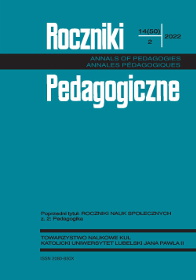Przekonania i oczekiwania studentów SGGW związane ze szkoleniami e-learning
Main Article Content
Abstrakt
Wraz z rozwojem technologii, czyli łatwiejszą dostępnością szybkich komputerów, Internetu o dużej przepustowości i świadomością ludzi, jak można wykorzystać komputer oraz z ich coraz większymi kompetencjami informatycznymi, e-learning znajduje wciąż nowe zastosowania we współczesnym świecie. Należy podkreślić, że e-learning to nie tylko wykorzystanie technologii, Internetu i komputera w nauczaniu, jest on także ściśle związany z kształceniem ustawicznym oraz ciągłym podnoszeniem kwalifikacji osób dorosłych.
Article Details
Numer
Dział
Artykuły
Bibliografia
Allen, Y., Spencer, S. (1983). The Broadcasting Chronology 1809-1980. North Ryde: Australian Film and Television School.
Clarke, A. (2007). E-learning – nauka na odległość. Warszawa: Wydawnictwa Komunikacji i Łączności.
Cox, D. D., Morison, W. J. (2000). The University of Louisville. Lexington: The University Press of Kentucky.
Dąbrowski, M. (2008). E-learning 2.0 – Przegląd technologii i praktycznych wdrożeń. Zastosowanie technologii i usług Web 2.0 w edukacji. Edukacja i Dialog, 5, 37-45.
Grzenia, J. (2006). Komunikacja językowa w Internecie, Warszawa: PWN.
Griffin, E. (2003). Podstawy komunikacji społecznej. Tłum. Olga Kubińska, Wojciech Kubiński, Magdalena Kacmajor, Gdańsk: Gdańskie Wydawnictwo Psychologiczne.
Hyla, M. (2007). Przewodnik po e-learningu. Warszawa: Wolters Kluwer.
Jakubiak-Zapalska, E. (2002). Nowa dydaktyka w sieci. W: L. H. Haber (red.), Polskie doświadczenia w kształtowaniu społeczeństwa informacyjnego: dylematy cywilizacyjno-kulturowe 395-402. Kraków: Wydawnictwo Akademii Górniczo-Hutniczej.
Janoś. T. (red.) (2004). Vademecum teleinformatyka. T. III: Komunikacja mobilna, bezpieczeństwo, technologie i protokoły sieciowe. Warszawa: Wydawnictwo IDG.
Juszczyk S. (2003). Edukacja na odległość. Kilka refleksji konstruktywistycznych i kognitywistycznych. Chowanna 1, 150-168.
Kaikumba, N., Cryer, P. (1987). Evaluating at a distance using cassette tape. Open Learning. The Journal of Open, Distance and e-Learning, 1, 59-61.
Knowles, M. S. Holton, E. F. Swanson, R. A. (2009). Edukacja dorosłych. Tłum. Miłosz Habura, Rozalia Ligus, Adrianna Nizińska. Warszawa: PWN.
Knowles, M. S. (1980). The Growth and Development of Adult Education. W: J. M. Peters (red.) Building an Effective adult Education Enterprise (s. 30-34). San Francisco: Jossey Bass.
Knox, A. B. (1985). Adult Learning and Proficiency. W: D. A. Kleiber, M. L. Maeh, (red.), Motivation and Adulthood (s. 14-18). London Greenwich, Conn: JAI Press.
Kupisiewicz, Cz. (1978). System Mannheimski. W: W. Okoń (red.), Szkoły eksperymentalne 1900-1975 (s. 174-185). Warszawa: WSiP.
Malewski, M. (2001). Modele pracy edukacyjnej z ludźmi dorosłymi. W: E. Przybylska (red.), Andragogiczne wątki, poszukiwania, fascynacje (s. 271-289). Toruń: Wydawnictwo Naukowe UMK.
Oleszak, W. (2011). Modele pracy edukacyjnej z ludźmi dorosłymi. General and Professional Education, 1, 35-36.
Penkowska, G. (2009). Komputery w edukacji. Od przedmiotu do metody kształcenia, Gdańsk: Wydawnictwo Uniwersytetu Gdańskiego.
Przybyła, W. Ratalewska, M. (2012). Poradnik dla projektujących kursy e-learningowe, Warszawa: Krajowy Ośrodek Wspierania Edukacji Zawodowej i Ustawicznej.
Rosenberg, M. J. (2001). E-learning: Strategies for delivering knowledge in the digital age. Montreal: McGraw-Hill.
Shimura, K. (2006). Computer-based learning and web-based training: A review for higher education. Bulletin of Faculty of Social Work, 6, 59-64. http://hrr.ul.hirosaki-u.ac.jp/dspace/bitstream/10634/5847/1/HiroGakuShakaiFukushi_6_59.pdf (dostęp: 05.05.2022).
Siemieniecki, B. (red.), (2007). Pedagogika medialna. T. 2. Warszawa: PWN.
Tyson, L. (1936). Ten Years of Educational Broadcasting. School and Society, 44, 225-231.
Clarke, A. (2007). E-learning – nauka na odległość. Warszawa: Wydawnictwa Komunikacji i Łączności.
Cox, D. D., Morison, W. J. (2000). The University of Louisville. Lexington: The University Press of Kentucky.
Dąbrowski, M. (2008). E-learning 2.0 – Przegląd technologii i praktycznych wdrożeń. Zastosowanie technologii i usług Web 2.0 w edukacji. Edukacja i Dialog, 5, 37-45.
Grzenia, J. (2006). Komunikacja językowa w Internecie, Warszawa: PWN.
Griffin, E. (2003). Podstawy komunikacji społecznej. Tłum. Olga Kubińska, Wojciech Kubiński, Magdalena Kacmajor, Gdańsk: Gdańskie Wydawnictwo Psychologiczne.
Hyla, M. (2007). Przewodnik po e-learningu. Warszawa: Wolters Kluwer.
Jakubiak-Zapalska, E. (2002). Nowa dydaktyka w sieci. W: L. H. Haber (red.), Polskie doświadczenia w kształtowaniu społeczeństwa informacyjnego: dylematy cywilizacyjno-kulturowe 395-402. Kraków: Wydawnictwo Akademii Górniczo-Hutniczej.
Janoś. T. (red.) (2004). Vademecum teleinformatyka. T. III: Komunikacja mobilna, bezpieczeństwo, technologie i protokoły sieciowe. Warszawa: Wydawnictwo IDG.
Juszczyk S. (2003). Edukacja na odległość. Kilka refleksji konstruktywistycznych i kognitywistycznych. Chowanna 1, 150-168.
Kaikumba, N., Cryer, P. (1987). Evaluating at a distance using cassette tape. Open Learning. The Journal of Open, Distance and e-Learning, 1, 59-61.
Knowles, M. S. Holton, E. F. Swanson, R. A. (2009). Edukacja dorosłych. Tłum. Miłosz Habura, Rozalia Ligus, Adrianna Nizińska. Warszawa: PWN.
Knowles, M. S. (1980). The Growth and Development of Adult Education. W: J. M. Peters (red.) Building an Effective adult Education Enterprise (s. 30-34). San Francisco: Jossey Bass.
Knox, A. B. (1985). Adult Learning and Proficiency. W: D. A. Kleiber, M. L. Maeh, (red.), Motivation and Adulthood (s. 14-18). London Greenwich, Conn: JAI Press.
Kupisiewicz, Cz. (1978). System Mannheimski. W: W. Okoń (red.), Szkoły eksperymentalne 1900-1975 (s. 174-185). Warszawa: WSiP.
Malewski, M. (2001). Modele pracy edukacyjnej z ludźmi dorosłymi. W: E. Przybylska (red.), Andragogiczne wątki, poszukiwania, fascynacje (s. 271-289). Toruń: Wydawnictwo Naukowe UMK.
Oleszak, W. (2011). Modele pracy edukacyjnej z ludźmi dorosłymi. General and Professional Education, 1, 35-36.
Penkowska, G. (2009). Komputery w edukacji. Od przedmiotu do metody kształcenia, Gdańsk: Wydawnictwo Uniwersytetu Gdańskiego.
Przybyła, W. Ratalewska, M. (2012). Poradnik dla projektujących kursy e-learningowe, Warszawa: Krajowy Ośrodek Wspierania Edukacji Zawodowej i Ustawicznej.
Rosenberg, M. J. (2001). E-learning: Strategies for delivering knowledge in the digital age. Montreal: McGraw-Hill.
Shimura, K. (2006). Computer-based learning and web-based training: A review for higher education. Bulletin of Faculty of Social Work, 6, 59-64. http://hrr.ul.hirosaki-u.ac.jp/dspace/bitstream/10634/5847/1/HiroGakuShakaiFukushi_6_59.pdf (dostęp: 05.05.2022).
Siemieniecki, B. (red.), (2007). Pedagogika medialna. T. 2. Warszawa: PWN.
Tyson, L. (1936). Ten Years of Educational Broadcasting. School and Society, 44, 225-231.

